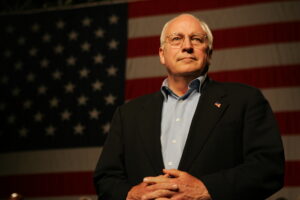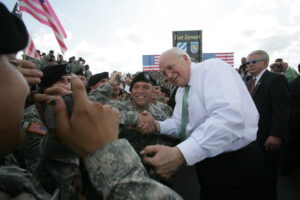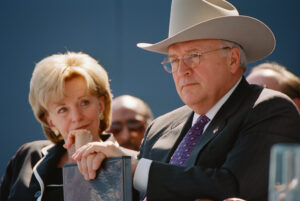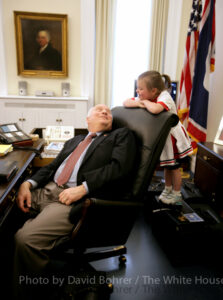With the recent passing of Vice President Dick Cheney, Five Questions With… turns to David Bohrer, who served as Vice President Cheney’s official photographer for eight years and chronicled nearly a million images that captured both the public and private moments of his tenure. Before joining the White House, Bohrer spent 15 years as a staff photographer at the Los Angeles Times, where he was part of three Pulitzer Prize-winning teams for news photography. In this Q&A, Bohrer reflects on the profound lessons he learned while documenting a consequential period in U.S. history — sharing memories of leadership in times of crisis, glimpses of the man behind the public figure, and the enduring impact of being entrusted with preserving Vice President Cheney’s legacy.
Q: Over the course of eight years, you captured countless moments of Vice President Cheney through your lens. Every photographer has that one favorite image that rises above the rest. If you had to choose a single photograph that best embodies your experience, which would it be, and what makes it so meaningful to you?
From almost a million images over the eight years, it is certainly difficult to narrow it down to one. But, one that I always think about is the image of the Vice President looking out the window aboard Marine Two as we circled over the crumbled remains of the west side of the Pentagon made by American Airlines Flight 77. It was quiet aboard the helicopter; everybody was in their own thoughts about the tragedy that had happened less than 24 hours ago. Vice President Cheney had served as the Secretary of Defense for President George H.W. Bush. He was now Vice President, and the two jobs, years apart, were colliding in tragic consequence. His thoughts at that moment could fill a book.
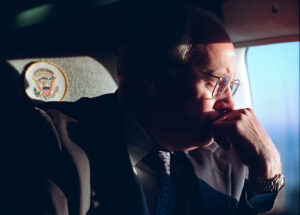
Q: Many people saw the public figure, but you saw the man behind the scenes. What’s something you wish more people understood about Vice President Cheney?
The public persona was vastly different than the actual Dick Cheney. He was a husband, a father and a grandfather – and he excelled at all those roles – all while exercising the duties of one of the most pressure-filled jobs in the country. He was probably the first vice president who didn’t want to be president – a truly unique distinction. He was always deferent to the President and shifted the spotlight if it ever came his way. As a result, his lack of public-facing glad-handing was perceived as a man who was mysterious and evasive. He surely must be evil, many thought as a result. He was even dubbed Darth Vader, a title he laughably embraced. But for those who spent time in his inner circle, it was frustrating. We saw him make many off-the-record trips to military bases, military hospitals, veteran events, and the like – without media and never announced. He did it because he felt in his heart, it was the right thing to do. The frustrating part for myself and others who witnessed it is that nobody else ever got to see it. He had a quick-witted sense of humor, which he sparingly dealt out to his staff, often at our own expense. He was the smartest guy in the room, and we joked that those of us staff who were there to help him do his job better were just in the way of him doing his job better.
Q: You were with Vice President Cheney on 9/11. What do you most remember about him from that day?
I remember the calm, cool demeanor of a man who was just escorted with just seconds notice by U.S. Secret Service Agent Jim Scott through the White House and to the President’s Emergency Operations Center at a pace he hadn’t run at since his college football days. While the weight of the initial moments and the day wore on, as buildings collapsed, citizens perished and the horror of the day played out on live TV, I witnessed as he commanded a room full of chiefs of staff, military aides, advisors, cabinet secretaries and many others with a staunch fortitude and unwavering thought process. Decisions were thoughtful and decisive, made with information as it came in and decades of wisdom. A clamoring room of voices came to a hush as he calmly and steadily made queries, sought specific counsel, and voiced decisions. He provided the President with thoughtful counsel and updates as the minutes, hours, and days progressed. It was a master class in leadership, at a time when many would’ve crumbled. Dick Cheney left an indelible mark on me in the eight years, but none more than that day.
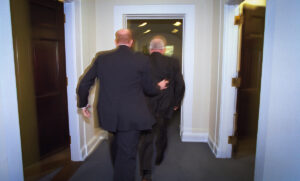


Q: Over the years, what did you learn from watching how the Vice President carried himself — in meetings, on the road, or with his team?
I learned there are few like him. It’s an age old saying, “listen more than you speak.” That’s exactly what he always did. He gathered facts – constantly. He was ceaselessly taking in information. He also treated everyone who worked for him with respect, as did the President. That became a trickle-down ethos in the Administration and made for an enviable and acclaimed work environment. Those who worked for them know and have a fierce loyalty as a result.
Q: Looking back, what did it mean to you — personally and professionally — to be entrusted with documenting Vice President Cheney’s legacy, and how did you get the job?
I originally applied to be one of the President’s photographers. Just after the Administration began, I was contacted by Eric Draper, the director of the White House Photo Office, to tell me that the VP’s initial photographer would not be continuing in the position. The VP had looked through a stack of portfolios, provided by Draper, and Cheney decided that he wanted me to come in for an interview – the next day!
I was in Los Angeles when I got that call relaying the request of the Vice President of the United States. After nearly dropping the phone in disbelief a couple times, I boarded a red eye flight and began the interview process at the White House at 8 a.m. the next day. One of the seven different interviews was with the Vice President. He was welcoming, gracious, and no-nonsense. After the remaining three, I was finally finished as the clock struck 3:30 p.m. I asked the head of VP Operations the obvious question, “So what’s the next step?” She said matter-of-factly, “Oh, you got the job. Can you start next week ?”
The role of a White House photographer is truly one of the best jobs at the White House. Whether it be the chronicling of the President or Vice President, you are a part of those principals’ daily lives. If they move from one room of the White House to the next, there’s a photographer with them – much less one state or country to the next. You get to see everything, be there for everything, and have the honor of recording history at its highest, most consequential level. We’re there at cabinet meetings, Oval Office meetings, campaigns and world trips. But also, for family events, holiday meals, the birth of grandchildren, and the adoption of new pets. There is truly no greater honor… and after all this, the wisdom we pass along to others: “Just don’t screw it up!”
Every year that goes by I grow into the lessons I knowingly and unknowingly learned from the eight years I spent there. With Vice President Cheney’s passing, I feel like I lost a father.
